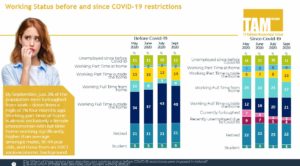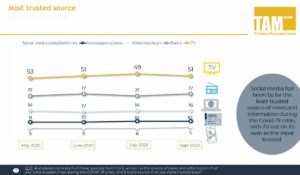Back in March 2020, life as we knew it shifted. The things that we took for granted just weeks before, such as travel, eating out, shopping trips – even sending our kids to school and seeing friends and family – temporarily ground to a total halt. TAM commissioned B&A to conduct the Reopening Ireland Tracker Study to conduct a real-time study in conjunction with the loosening of restrictions in Ireland (May-September) to see how Irish people were reacting to the monumental changes in their lives.
The main findings from the study were:
Fluid Workforce
As Covid restrictions have lifted, the proportion of people working from home has dropped by a third. There is still a long way to go however before everyone is back in the workplace, and the indications are that many if not a majority will settle on a blend of home/office-based work.

There is uncertainty for those working at home as to when they will return to work with only a third reporting they will return within the next three months. This figure is lower for women at 25%
Implications for advertisers
With regard to the style and tone of communications, we should also be cogniscent of the fact that these changes have heralded a shift in the nature and quality of the work/life experience, with many referring to a much more relaxed and less stressful experience whereby work can be incorporated to their everyday routines and lifestyle, rather than the other way around
Spending Power
Throughout all phases of the crisis, approaching six in ten of all adults have been managing to save money – particularly so amongst the 18-34 years and 65 years+ age groups. As further evidence of the financial wellbeing of sizeable proportions of the population, over four in ten have by now managed to clear or reduce debt since the beginning of the Pandemic.
While the damage inflicted on countless businesses and the economy at large has been enormous (and let’s not even talk about Brexit!), the fact is that consumers’ confidence in their personal finances for the year ahead has been consistently improving, no doubt driven by the fact that a large majority tell us their spending power has either remained the same or improved since the beginning of the crisis, as manifested by significant levels of savings and debt reduction.
Implications for advertisers
We cannot ignore the circa three in ten who are struggling financially, and those who may find themselves in the same position as Government supports are wound down. The importance of price as a purchase decision factor will therefore remain even more acute over the next year or two, and is a factor which local businesses and Irish brands in particular will need to be aware of in retaining the new consumers they have found during the pandemic
News and Information
As the crisis progressed, more and more people turned to TV as by far the single most important source of news and information. One of the more stark findings of the research has been the extent to which people have turned to TV news and information to keep up to date on Covid-19 developments. The medium far out-strips all others as the go-to source of current, relevant and engaging content to help people plan their lives and retain a sense of perspective on the bigger picture.
The medium has also performed a critical role in entertaining and stimulating its audiences, whether that be through more considered solus viewing or family bonding time. And all of this before the aching need for the full return of the live TV sport viewing experience!
Implications for advertisers
Whether by way of linear or BVOD consumption, the breadth and scope of the TV audience has only strengthened as a consequence of recent developments.
Trust
One overarching theme that emerged in the research was that TV was very much seen as a credible, trusted news source with integrity. Social media has been by far the least trusted source of news and information during the Covid-19 crisis, with TV out on its own as the most trusted.

Implications for advertisers
While the perceived benefits of TV are obvious to all audiences from a practical, social and emotive perspective, the research also confirms that the medium represents the most trusted advertising medium.
After word of mouth, TV is identified as a key source for ideas as to which purchases to make, with consumers acknowledging the role of TV advertising in prompting subsequent related online activity, consideration or purchase.
The full deck for this study is available by visiting the Client Area of our website